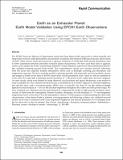Earth as an Extrasolar Planet: Earth Model Validation Using EPOXI Earth Observations
Author(s)
Robinson, Tyler D.; Meadows, Victoria S.; Crisp, David; Deming, Drake; A'Hearn, Michael F.; Charbonneau, David; Livengood, Timothy A.; Seager, Sara; Barry, Richard K.; Hearty, Thomas; Hewagama, Tilak; Lisse, Carey M.; McFadden, Lucy A.; Wellnitz, Dennis D.; ... Show more Show less
DownloadRobinson-2011-Earth as an Extrasol.pdf (631.7Kb)
PUBLISHER_POLICY
Publisher Policy
Article is made available in accordance with the publisher's policy and may be subject to US copyright law. Please refer to the publisher's site for terms of use.
Terms of use
Metadata
Show full item recordAbstract
The EPOXI Discovery Mission of Opportunity reused the Deep Impact flyby spacecraft to obtain spatially and temporally resolved visible photometric and moderate resolution near-infrared (NIR) spectroscopic observations of Earth. These remote observations provide a rigorous validation of whole-disk Earth model simulations used to better understand remotely detectable extrasolar planet characteristics. We have used these data to upgrade, correct, and validate the NASA Astrobiology Institute's Virtual Planetary Laboratory three-dimensional line-by-line, multiple-scattering spectral Earth model. This comprehensive model now includes specular reflectance from the ocean and explicitly includes atmospheric effects such as Rayleigh scattering, gas absorption, and temperature structure. We have used this model to generate spatially and temporally resolved synthetic spectra and images of Earth for the dates of EPOXI observation. Model parameters were varied to yield an optimum fit to the data. We found that a minimum spatial resolution of 100 pixels on the visible disk, and four categories of water clouds, which were defined by using observed cloud positions and optical thicknesses, were needed to yield acceptable fits. The validated model provides a simultaneous fit to Earth's lightcurve, absolute brightness, and spectral data, with a root-mean-square (RMS) error of typically less than 3% for the multiwavelength lightcurves and residuals of 10% for the absolute brightness throughout the visible and NIR spectral range. We have extended our validation into the mid-infrared by comparing the model to high spectral resolution observations of Earth from the Atmospheric Infrared Sounder, obtaining a fit with residuals of 7% and brightness temperature errors of less than 1 K in the atmospheric window. For the purpose of understanding the observable characteristics of the distant Earth at arbitrary viewing geometry and observing cadence, our validated forward model can be used to simulate Earth's time-dependent brightness and spectral properties for wavelengths from the far ultraviolet to the far infrared. Key Words: Astrobiology—Extrasolar terrestrial planets—Habitability—Planetary science—Radiative transfer. Astrobiology 11, 393–408.
Date issued
2011-01Department
Massachusetts Institute of Technology. Department of Earth, Atmospheric, and Planetary SciencesJournal
Astrobiology
Publisher
Mary Ann Liebert, Inc.
Citation
Robinson, Tyler D. et al. “Earth as an Extrasolar Planet: Earth Model Validation Using EPOXI Earth Observations.” Astrobiology 11 (2011): 393-408. Web. 28 Oct. 2011. © 2011 Mary Ann Liebert, Inc.
Version: Final published version
ISSN
1531-1074
1557-8070